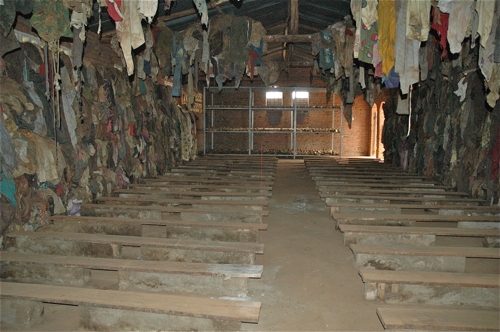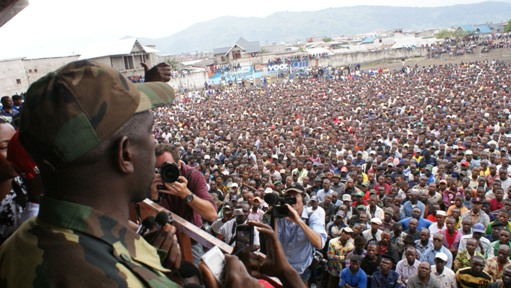
Note: Media is just now reporting on the second leaked document discussed in the latter part of this post.
Americans are out of the loop when it comes to rigorous analysis of foreign policy in in the Democratic Republic of Congo. They may be vaguely aware that international opinion has coalesced around a report issued by the United Nations that is critical of Rwanda. Americans may not realize that the premature leaking of this report has had broad consequences for the region and has influenced media coverage as well as humanitarian aid. Most recently, the United Kingdom decided to freeze $34 million of aid to Rwanda.
 Genocide Memorial in Rwanda (Credit: G. Nienaber)But Americans don't like to be duped when it comes to the central tenet of the American justice system -- that the accused is innocent until proven guilty.
Genocide Memorial in Rwanda (Credit: G. Nienaber)But Americans don't like to be duped when it comes to the central tenet of the American justice system -- that the accused is innocent until proven guilty.
Let's offer the thesis that public opinion has been railroaded with respect to Rwanda amid accusations that it is supplying aid to a newly minted and highly successful rebel army in eastern Congo.
There is no scenario that the American psyche enjoys more than a courtroom drama rife with corrupt prosecutors, judges on the take, compromised witnesses, faked evidence, dishonest snitches, and jury tampering. It is dramatic to entertain the possibility that justice will not necessarily prevail, but Americans abhor a lie in the courtroom. Look no further than the mesmerizing real life dramas of Casey Anthony and O.J. Simpson. Law and Order: SVU, Criminal Minds, Without a Trace, The Closer, Harry's Law, Cold Case and Columbo are a few of the fictionalized television dramas that come to mind.
If we want to take American history as a guide into fascination with corruption in the courtroom, there is no more shameful real life drama than the 1692 Salem Witch Trials, which have been part of a national dialogue for over 300 years.
Consider this exchange during the examination of accused "witch" Bridget Bishop by inquisitor John Hathorne.
Hathorne: How do you know that you are not a witch?Bishop: I do not know what you say. . .I know nothing of it.Hathorne: Why look you, you are taken now in a flat lye (sic).
A reasonable argument can be made that Rwanda is the victim of a similar witch-hunt in the Security Council of the United Nations.
Here is a quote from the legal review of the charges leveled against Rwanda.
A "rush to judgment" in the Group of Expert's reports; insufficient recounting of Rwanda's position; no right of rebuttal in the interim report; and only a limited right of rebuttal in the addenda.
Even the accused "witch," Bridget Bishop, had the right to a rebuttal before being called a liar.
How would Americans react to the possibility that they have been fed a frenzy of lies, paranoia, and innuendo based upon a leaked report? Is leaking a report comparable to jury tampering?
A "group of experts" was appointed by the United Nations in much the same manner as was Salem prosecutor John Hathorne. There is reason to believe that the "group of experts," instead of offering counsel to the U.N. Sanctions Committee, assumed the role of judge, jury and executioner by declaring Rwanda is guilty of supplying arms to a Congolese Rebel Army (M23/CRA).
The result has been the unfortunate withholding of foreign aid to Rwanda, still recovering from the scars of the 1994 genocide, as well as acute embarrassment for a country that, while still struggling, is one of the biggest success stories in Africa. This is not to say that there are not serious societal problems remaining in Rwanda, but in the particular issue of supplying aid to a foreign army, Rwanda has been the victim of a whispering campaign similar to that endured by the "witches" in the Salem trials. The historical parallels are instructive.
John Hathorne embodied all that America has come to loathe in a corrupt prosecutor. A local and unremarkable Salem magistrate, Hathorne, was chosen by Governor William Phipps to be a judge in the Salem Trials. While promoting the presumption of guilt rather than innocence, Hathorne inhabited the role of prosecutor rather than that of impartial judge. Hathorne was a true believer in witches and, in his megalomania, thought he knew how to expose them. He was able to encourage the selective perception of witches lurking in every household.
A master at encouraging the accused to testify beyond their own forced confessions, Hathorne elicited finger-pointing that resulted in a farce of a "trial," where rumor and innuendo became "fact." This increased the number of accusations and resulted in the conviction of 200 "witches" and the execution of 20 on absurd accusations of consorting with the Devil. After Governor Phipps wife was also accused of being a witch, he prohibited further arrests, released many of the accused, and dissolved the special court. There was a lot of recanting by judges and a day of fasting to atone for the profane miscarriage of justice. But it was too late for the dead.
In an eerie parallel to the current conflict, English rulers William and Mary had started a proxy war with France in the American colonies in 1689. Upstate New York, Nova Scotia and Quebec, were flattened by conflict and refugees poured into neighboring counties and Salem Village. The refugees, or Internally Displaced Persons (IDPS) in today's jargon, were a strain on resources and pitted agrarian interests against foreign trade. Land and trade wars erupted, neighbor was pitted against neighbor -- all against the backdrop of a developing frontier and a harsh winter.
Today, due to the ongoing conflict in Congo, the region is reeling with streams of refugees (IDPS) and the responsibility of maintaining displacement camps for Congolese who cannot or will not go home. Why not go home? They fear persecution by remnants of the genocide army (FDLR) that fled from Rwanda to Congo in 1994 after killing up to one million. The government of Congo, almost 1200 miles away by road in Kinshasa, has shown no ability to care for the refugees. Like the early American frontier, Congo has been plundered and manipulated by foreign interests in search of its mineral and trade wealth. China and the United States are big players.
The resulting chaos has fostered the emergence of dozens of rebel armies over the years. When the M23 -- now the Congolese Revolutionary Army -- rebel group formed in April 2012, it posed a threat both to the government of Congo and to the United Nations "peacekeeping force," MONUSCO. MONUSCO has been unable to keep the peace despite a budget allocation of $1.4 billion per year. The threat of a successful rebel army that could possibly topple the government was a greater threat than imaginary Salem witches. The M23 was all too real, and someone had to be blamed. See TIME Magazine article: "The UN Debacle in Eastern Congo."
Simple-minded Puritan villagers in Salem believed the hardships and conflicts permeating daily life were the work of the Devil. The United Nations Group of Experts also had to find a scapegoat, and the scapegoat became Rwanda.
These reports are filed every year; usually with different authors. Media tends to ignore the bulk of the reports, even though they can be an excellent source of reliable information. The 2011 report is recognized as being generally reliable. There are strict guidelines regarding methodology, transparency, verified documentary evidence, and independent verifiable sources. All of these requirements are in question in the 2012 report.
It can be reasonably demonstrated that the accusations present in the 2012 report would never hold up in court. Rwanda hired a law firm to compile a rebuttal and you can read it here. The most egregious charge against the document is that its principal coordinator authored a paper in which he demonstrated clear bias in favor of the perpetrators of the Rwandan genocide (FDLR). The paper was scrubbed from the Internet when his impartiality was challenged, but you can read it here on this Russian cache.
The repetition of false accusations never makes them true, but if they are repeated long enough and without rebuttal they can morph into "fact." Once the lie or misinformation has been spread, selective perception takes over in the psyche depending on whether one believes the lie. Information is unconsciously filtered through personal bias and first impressions.
The coordinator of the Group of Experts, Stephen Hege, produced a second leaked report that is a perfect example of using selective perception to spread accusations that are unproven.
The crux of the second document, dated November 26, 2012, is that rebel soldiers were seen in the captured city of Goma "marching through downtown dressed in a combination of RDF (Rwanda) and new M23 (rebel) uniforms."
Anyone can go online and order uniforms, made in China, that match camouflage patterns worn by regional armies. Does that mean if you see a soldier in a pattern worn by US military that the United States is supplying the rebel army?
 Is this U.S. issue? Rwandan? Chinese? (Photo courtesy of M23)
Is this U.S. issue? Rwandan? Chinese? (Photo courtesy of M23)
A critical analysis will ask why this photo, freely available on the Internet, of the commander of the M23 rebels wearing U.S. patterns was left out of the report. Reason? It does not fit the narrative developed and nurtured by a biased panel.
 Colonel Vianney Kazarama, M23/CRA (Photo Permission from M23)
Colonel Vianney Kazarama, M23/CRA (Photo Permission from M23)
Selective perception is evidenced in this document supposedly showing "M23 combatants marching into Goma wearing RDF uniforms." Again anyone can order this pattern from acu.com.
How can we fight bias, megalomaniacal investigators, and selective perception?
Perhaps it is time to bring Kyra Sedgwick's Brenda Leigh Johnson (The Closer), out of retirement. The Group of Experts would not have a prayer facing her withering questioning.
Cross-posted at OPEDNEWS
